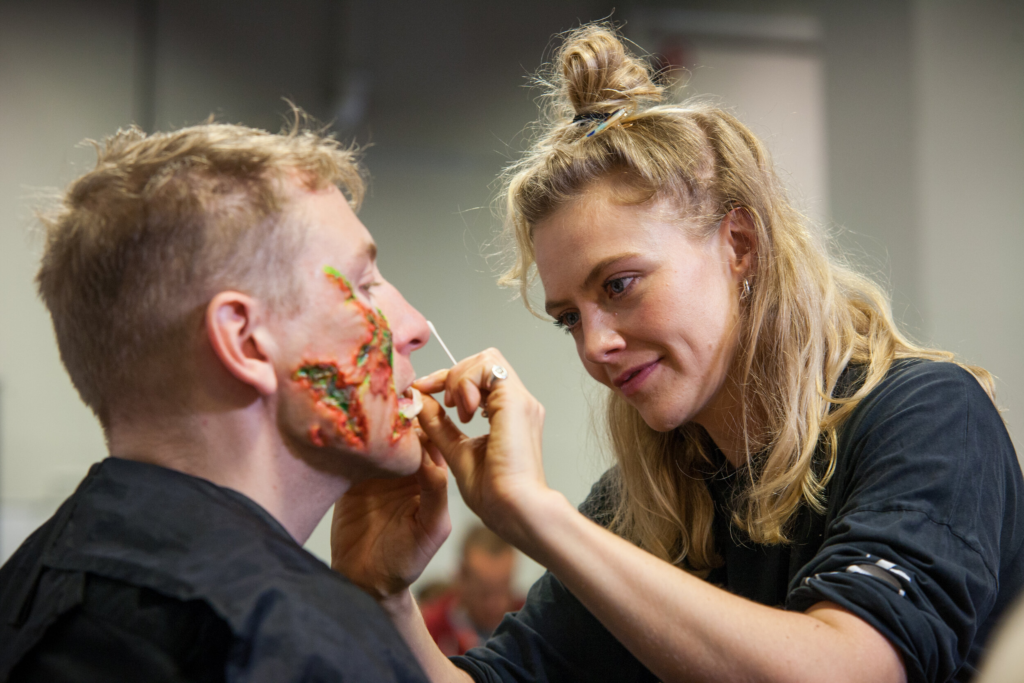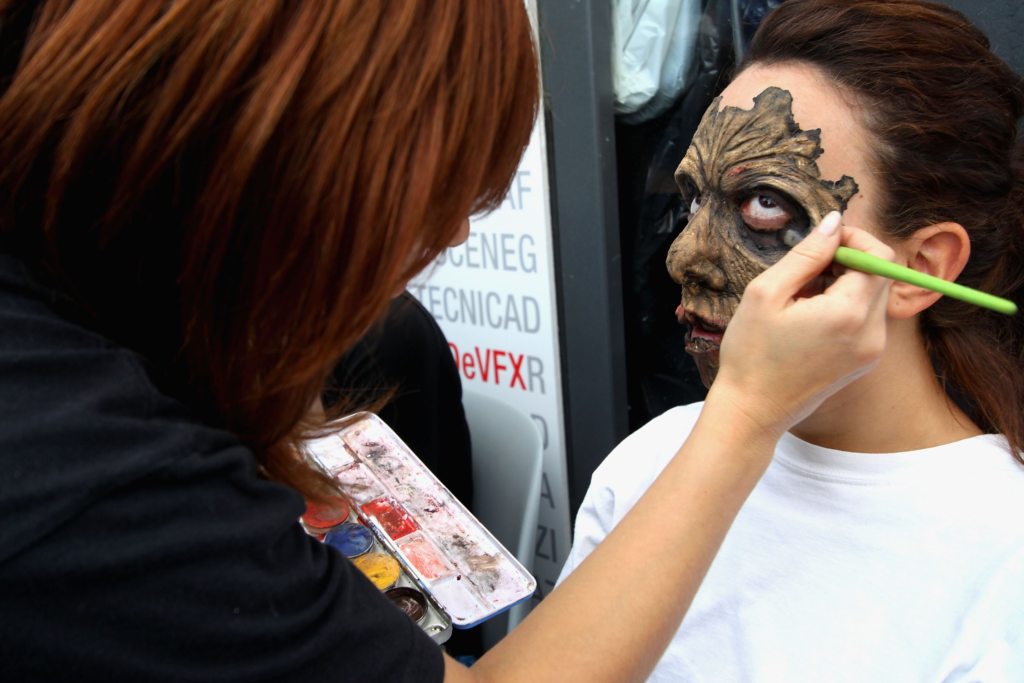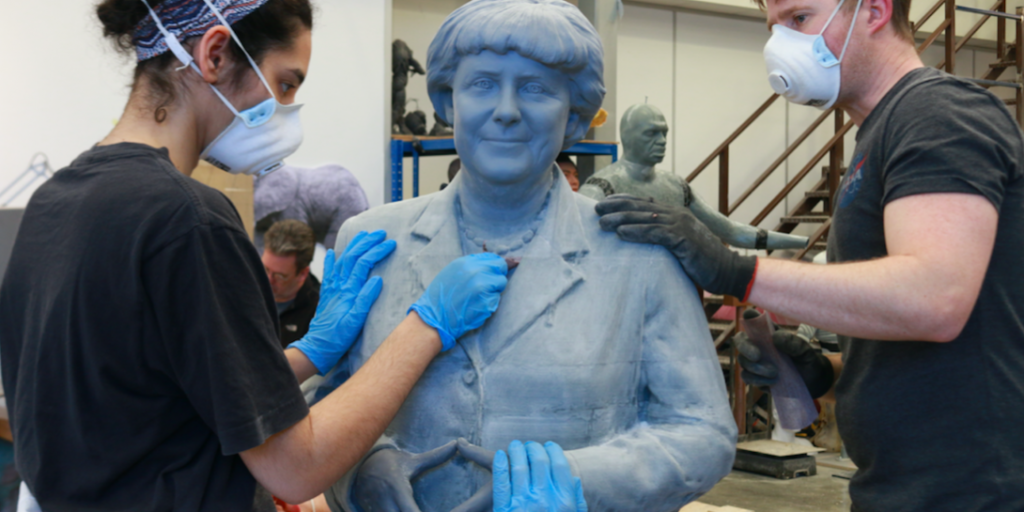Prosthetics artist (1 years diploma)
Prosthetics artist click here
Brief Job Description: Individuals at this job are responsible for creating and
applying prosthetics for artists.
Personal Attributes: This job requires the individual to identify requirements,
design and prepare prosthetics as per the design requirements of the shoot. The
individual must be well-versed with the principles and techniques of creating
prosthetics including moldings, casting, sculpting etc. using appropriate
materials. The individual must be able to apply prosthetics to artists using
appropriate techniques and maintain continuity during consecutive shoots.

Description
Airbrushing
A technique to apply multiple liquid make-up products on the skin by pushing
them through a nozzle to create a mist of droplets that settle on the skin
Contouring The art of shading and highlighting areas of the skin, features etc.
Cosmetology The art of applying cosmetics and study of their uses
Exfoliate
Process of removing dirt, dead cells and cleaning the skin using a gentle abrasive
product
Hair colour A hair product that is used to change the colour or appearance of the hair
Hair elasticity The ability of the hair to stretch and return back to its original length
Prosthetics
The art of creating false limbs, body parts using sculpting, moulding, casting
techniques for use in special effects make-up
Skin test
A process where a small amount of the product is applied to the skin to test for
any adverse skin reactions
Sector Sector is a conglomeration of different business operations having similar
businesses and interests. It may also be defined as a distinct subset of the
economy whose components share similar characteristics and interests.
Sub-sector Sub-sector is derived from a further breakdown based on the
characteristics and interests of its components.
Vertical Vertical may exist within a sub-sector representing different domain areas
or the client industries served by the industry.
Occupation Occupation is a set of job roles, which perform similar/related set of
functions in an industry
Function Function is an activity necessary for achieving the key purpose of the
sector, occupation, or area of work, which can be carried out by a person
or a group of persons. Functions are identified through functional analysis
and form the basis of OS.

Sub-functions Sub-functions are sub-activities essential to fulfill the achieving the
objectives of the function.
Job role Job role defines a unique set of functions that together form a unique
employment opportunity in an organization.
Occupational Standards
(OS)
OS specify the standards of performance an individual must achieve when
carrying out a function in the workplace, together with the knowledge and
understanding they need to meet that standard consistently. Occupational
Standards are applicable both in the Indian and global contexts.
Performance Criteria Performance Criteria are statements that together specify the standard of
performance required when carrying out a task
National Occupational
Standards (NOS)
NOS are Occupational Standards which apply uniquely in the Indian
context.
Qualifications Pack Code Qualifications Pack Code is a unique reference code that identifies a
qualifications pack.
Qualifications Pack(QP) Qualifications Pack comprises the set of OS, together with the educational,
training and other criteria required to perform a job role. A Qualifications
Pack is assigned a unique qualification pack code.
Unit Code Unit Code is a unique identifier for an Occupational Standard, which is
denoted by an
Unit Title Unit Title gives a clear overall statement about what the incumbent should
be able to do
Qualifications Pack For Prosthetics artist
Keywords /Terms Description
NOS National Occupational Standard(s)
QP Qualifications Pack
NSQF National Skill Qualifications Framework
NVEQF National Vocational Education Qualifications Framework
NVQF National Vocational Qualifications Framework
Description Description gives a short summary of the unit content. This would be
helpful to anyone searching on a database to verify that this is the
appropriate OS they are looking for.
Scope Scope is the set of statements specifying the range of variables that an
individual may have to deal with in carrying out the function which have a
critical impact on the quality of performance required.
Knowledge and
Understanding
Knowledge and Understanding are statements which together specify the
technical, generic, professional and organizational specific knowledge that
an individual needs in order to perform to the required standard.
Organizational Context Organizational Context includes the way the organization is structured and
how it operates, including the extent of operative knowledge managers
have of their relevant areas of responsibility.
Technical Knowledge Technical Knowledge is the specific knowledge needed to accomplish
specific designated responsibilities.
Core Skills/Generic Skills Core Skills or Generic Skills are a group of skills that are key to learning and
working in today’s world. These skills are typically needed in any work
environment. In the context of the OS, these include communication
related skills that are applicable to most job roles.
Description
NOS National Occupational Standard(s)
QP Qualifications Pack
NSQF National Skill Qualifications Framework
NVEQF National Vocational Education Qualifications Framework
NVQF National Vocational Qualifications Framework
Manage Hair, Make-up and Prosthetics supplies
Description This OS unit is about managing hair, make-up and prosthetics resources and supplies,
and making purchases whenever necessary
Scope This unit/task covers the following:
Evaluating material and equipment
Selecting and purchasing relevant products/services
Monitoring stocks of products

Note:
This task may be covered by Senior Designers or Producers on larger productions. On
smaller productions a Make-up Artist, Hairdresser or Prosthetics Artist may be solely
responsible.
Performance Criteria (PC) w.r.t. the Scope
Element Performance Criteria
Evaluating material
and equipment
To be competent, the user/individual on the job must be able to:
PC1. evaluating materials on quality, quantity, type, costs
PC2. determine the amount and quality of resources, materials, tools and
equipment required to meet design specifications
PC3. determine where and how resources should be labeled, stored and arranged
Selecting and
purchasing relevant
products/ services
PC4. select the providers of materials and equipment and purchase adequate
quantity and type of products, in line with creative, technical and budgetary
requirements, in consultation with/supervision of Senior Designers and
Producers if necessary
Monitoring stocks
PC5. monitor and replenish stock of hair, make-up or prosthetics resources, as per
requirements
Knowledge and Understanding (K)
A. Organizational
Context
(Knowledge of the
company /
organization and
its processes)
The user/individual on the job needs to know and understand:
KA1. the technical, resource, budget and time constraints applicable
KA2. the list of vendors from whom the organization has procured materials and
supplies in the past
KA3. special requirements of the director/ production designer / artists’ (if any)
KA4. the role and requirements of key departments be liaised with, especially
costumes, camera and lighting where the team has the maximum interaction
KA5. the creative and technical requirements of the production
KA6. the hair, make-up and prosthetics design concept agreed upon with the
director/ production designer and artists
B. Technical Knowledge
The user/individual on the job needs to know and understand:
KB1. the principles of cosmetology, hair care and prosthetics application
KB2. the features, characteristics, advantages, disadvantages, costs etc. of
different types of materials, tools and equipment
KB3. common skin diseases, allergies, disorders and reactions
KB4. where and how to source make up, hair and prosthetics materials, tools and
equipment
KB5. how to select materials, tools and equipment that suits the artists’ skin type
and conditions
KB6. how to obtain special materials or equipment based on artists’ physical needs
or artistic preferences
KB7. how to handle products to avoid damage or spillages
KB8. where and how resources should be labeled, stored and arranged
KB9. health and safety guidelines, including common allergies that could occur
from using materials
Skills (S) (Optional)
A. Core Skills/
Generic Skills
Writing Skills
The user/individual on the job needs to know and understand how to:
SA1. make an accurate list of resources to be purchased along with details such as
quantity, cost, vendor name etc.

SA2. fill out a purchase order form/petty cash form and get the appropriate
approvals for purchase of materials
SA3. keep accurate records of what you have ordered and what has been supplied
SA4. keep accurate records of expenditure and associated documents, receipts etc.
SA5. update stock records as appropriate
Reading Skills
The user/individual on the job needs to know and understand how to:
SA6. refer to hair, make-up or prosthetics designs, vendor catalogues, websites
etc. to gather information on materials to be purchased
SA7. read the production schedules and deadlines to ensure that materials are
available in advance
Oral Communication (Listening and Speaking skills)
The user/individual on the job needs to know and understand how to:
SA8. communicate effectively with vendors, in consultation with/supervision of
senior designers and producers if necessary
SA9. discuss and agree on the final list of resources to be purchased with the
director/ production designer and/ or the artists
SA10. liaise with the finance departments to receive cash for purchases
B. Professional Skills Decision Making
The user/individual on the job needs to know and understand how to:
SB1. select the correct quantity and types of materials required, taking into
account the design, production schedules and deadlines
SB2. select materials and equipment vendors who are able to meet the creative
and budgetary requirements
Plan and Organize
The user/individual on the job needs to know and understand how to:
SB3. ensure that the materials, tools and equipment are sourced prior to
commencement of production
Customer Centricity
The user/individual on the job needs to know and understand how to:
SB4. be creative and imaginative as per the changes or updations in the story or
characters

Problem Solving
The user/individual on the job needs to know and understand how to:
SB5. take appropriate action in the event of shortfalls in the quantity and quality of
materials, staff or facilities
SB6. monitor expenditure and anticipate budget over-spending and agree suitable
solutions
SB7. deal with supply delays promptly and effectively
SB8. check products to ensure they are not damaged and arrange replacement,
where required
Analytical Thinking
The user/individual on the job needs to know and understand how to:
SB9. monitor the nature and quality of vendors materials, tools and equipment for
future purchases
Critical Thinking
The user/individual on the job needs to know and understand how to:
SB10. appraise the quality of own work to ensure it is in line with the expected
quality standards
Create and pply prosthetics
Description This OS unit is about creating, applying, maintaining and removing prosthetics to meet
design requirements
Scope This unit/task covers the following:
Understanding requirements
Creating prosthetics
Removing prosthetics
Performance Criteria (PC) w.r.t. the Scope
Element Performance Criteria
Understanding
requirements
To be competent, the user/individual on the job must be able to:
PC1. identify and confirm requirements for prosthetic pieces as per the design brief
PC2. create pattern to fit the individual artists’ head/body shape using accurate
measurements to produce a bald cap, facial parts, scars etc.
Creating prosthetics PC3. produce original large life casts for face/ full head/ sectional and body casts,
and original small life casts for prosthetic pieces (facial features) as required
PC4. create large/extensive prosthetics (e.g. large facial pieces, multiple or
overlapping appliances and large body pieces) and small prosthetic pieces (e.g.
small facial parts) as required
PC5. prepare the artist’s skin, hair, facial hair and clothing and apply skin compatible
adhesives in positions that permit the required mobility and security of the
prosthetics during shooting
PC6. position prosthetics to meet the design requirement on camera
Removing prosthetics
PC7. remove the cast safely and restore the artist’s skin and hair to its original
condition
Knowledge and Understanding (K)
A. Organizational
Context
(Knowledge of the
company /
organization and
its processes)
The user/individual on the job needs to know and understand:
KA1. the creative and technical requirements of production
KA2. the technical, resource, budget and time constraints applicable
KA3. the production schedules and dates by when prosthetics would need to be
created and used by artists
KB1. the required mobility and security of prosthetics
KB2. the templates, measurements and block size that are appropriate for the artist
KA4. environmental factors at the shooting venue e.g. temperature, humidity etc.
and lighting and camera requirements
KA5. the types of make-up available for use
B. Technical Knowledge
The user/individual on the job needs to know and understand:
KB1. the principles of prosthetics
KB2. techniques such as moulding, casting, sculpting etc. and materials such as clay,
rubber, silicone, plastic etc. used to create prosthetics
KB3. the fundamentals of skin theory
KB4. the human anatomy and face structure
KB5. the fundamentals and principles of drawing and colour theory
KB6. theory of bruising and application techniques including blood, dirt etc.
KB7. the history of make-up, including period styles and techniques
KB8. appropriate techniques, materials and methods for sculpting, moulding and
casting prosthetics, realistic masks and anatomical props such as body parts,
heads etc.
KB9. how to ensure that appropriate block release agents and sealers are used
KB10. how to trim and mark the completed impression accurately and prevent it from
deterioration, distortion or damage
KB11. how to use the correct make-up, colouring and finishing techniques for the
prosthetics
KB12. how to clean tools and equipment
KB13. storage and disposal methods for prosthetic pieces and used materials
KB14. how to obtain a replica of the artist’s features without defects or distortion of
the cast
KB15. applicable health and safety requirements

Skills (S) (Optional)
A. Core Skills/
Generic Skills
Writing Skills
The user/individual on the job needs to know and understand how to:
SA1. keep accurate records of measurements, methods, formula and process to
enable creation of the required design and future replication
Reading Skills
The user/individual on the job needs to know and understand how to:
SA2. research/ gather suitable references to help create prosthetics
Oral Communication (Listening and Speaking skills)
The user/individual on the job needs to know and understand how to:
SA3. confirm requirements for prosthetics from the director/ production designer
SA4. check with artist’s about past allergies and other sensitivities
SA5. explain the preparation, casting and removal techniques to the artist and
provide opportunities for questions
SA6. ensure the artist is clear on what to do if an emergency arises during the
process
SA7. obtain medical advice and other supervision permission where necessary
B. Professional Skills Decision Making
The user/individual on the job needs to know and understand how to:
SB1. decide upon the appropriate placement of prosthetics, manage overlaps and
blend edges in relation to the artist and in accordance to the design brief
Plan and Organize
The user/individual on the job needs to know and understand how to:
SB2. ensure that prosthetics are created within the allocated time according to the
production schedule
Customer Centricity
The user/individual on the job needs to know and understand how to:
SB3. treat the artist with care and ensure they are made as comfortable as possible
during the process
SB4. position the artist to minimize personal discomfort
Problem Solving
The user/individual on the job needs to know and understand how to:
SB5. check artists’ history of allergies or other sensitivities and confirm whether the
artist has any medical condition that could preclude them from having a cast
taken
SB6. perform skin tests and take appropriate action in the event of an adverse skin
reaction
SB7. remove the prosthetic carefully to minimize the artists discomfort
SB8. prevent deterioration or distortion to the sculptures, moulds and resultant
prosthetic appliances
Critical Thinking
The user/individual on the job needs to know and understand how to:
SB9. check artists’ prosthetics against specifications for continuity
Analytical Thinking
The user/individual on the job needs to know and understand how to:
SB10. be creative and imaginative as per the changes or updations in the story or
characters
SB11. have a keen eye for detail and maintain an aesthetic sense towards colour
Shapes, forms and the final output
Manage helpers and trainees
Description This OS unit is about managing helpers and trainees while producing the required hair,
make-up and prosthetics according to the design brief
Note:
This task may be covered by Senior Designers or Producers on larger productions. On
smaller productions a Make-up Artist, Hairdresser or Prosthetics Artist may be solely
responsible.
Scope This unit/task covers the following:
Communicating information
Ensuring that the helpers/trainees assist correctly
Performance Criteria (PC) w.r.t. the Scope
Element Performance Criteria
Communicating
information
To be competent, the user/individual on the job must be able to:
PC1. inform, or assist in informing, trainees/helpers of the hair, make-up and
prosthetics process and of their responsibilities and role in the process
PC2. ensure, or assist in ensuring, that the trainees/helpers know how to find and
operate the materials, tools and equipments that will be required during the
process
PC3. provide clear and precise instructions to trainees/helpers during the process
and ensure they are working effectively to meet the production schedule
Ensuring that
trainees/ helpers
assist correctly

PC4. monitor and evaluate the work of trainees/helpers in an effective, unobtrusive
and objective manner
PC5. provide trainees/helpers with the opportunity to contribute and try out the
work for themselves.
Knowledge and Understanding (K)
A. Organizational
Context
(Knowledge of the
company /
organization and
its processes)
The user/individual on the job needs to know and understand:
KA1. the creative and technical requirements of production
KA2. the technical, resource, budget and time constraints applicable
KA3. the production schedules and dates by when hair, make-up or prosthetics
would need to be created
KA4. the work areas, process and activities involved
B. Technical Knowledge
The user/individual on the job needs to know and understand:
KB1. how to plan the work for helpers/trainees and assign responsibilities
KB2. how to use and/or operate the materials, tools and equipments required
during the hair, make-up or prosthetics process
KB3. the resources available for training helpers/trainees
KB4. how to utilize the resources available in the best possible manner
KB5. how to provide constructive feedback that could help helpers/trainees
improve their performance
KB6. legislation, regulations and codes of practice that are applicable to managing
other people and to the work being undertaken
KB7. how to ensure that trainees adhere to applicable health and safety
requirements at all times
National Occupational Standard
MES/N1806 Manage helpers and train
Writing Skills
The user/individual on the job needs to know and understand how to:
SA1. document plan for workers that encapsulates their role and responsibilities in
the hair, make-up or prosthetics process
Oral Communication (Listening and Speaking skills)
The user/individual on the job needs to know and understand how to:
SA2. advise trainees on the appropriate use of standard procedures, materials, tools
and equipments
SA3. encourage trainees to ask questions regarding aspects of the design brief
SA4. provide constructive individual feedback to trainees on their work and
encourage them to improve future performance
Reading Skills
The user/individual on the job needs to know and understand how to:
SA5. read and research any production specifications, where necessary and
communicate with the team
B. Professional Skills Plan and Organize
The user/individual on the job needs to know and understand how to:
SB1. plan the hair, make-up and prosthetics process and activities and identify
activities where helpers/trainees could assist
Problem Solving
The user/individual on the job needs to know and understand how to:
SB2. monitor the work of trainees and demonstrate how they could address
potential problems
SB3. find workable solutions promptly for any problems which could adversely
impact upon the production schedule
SB4. report any problems concerning the management of trainees
Critical Thinking
The user/individual on the job needs to know and understand how to:
SB5. evaluate own performance in the management of trainees and consult the
relevant person for feedback
Customer Centricity
The user/individual on the job needs to know and understand how to:
SB6. check that team work meets project creative requirements
Analytical Thinking
The user/individual on the job needs to know and understand how to:
SB7. identify issues that may arise during production/ probe into issues highlighted
by the production team and explore options to resolve them proactively
Decision making
The user/individual on the job needs to know and understand how to:
SB8. assign action plan for all team members as per their skills
Maintain workplace health and safety
Description This OS unit is about contributing towards maintaining a healthy, safe and secure
working environment
Scope This unit/task covers the following:
Understanding the health, safety and security risks prevalent in the workplace
Knowing the people responsible for health and safety and the resources available
Identifying and reporting risks
Complying with procedures in the event of an emergency
Performance Criteria (PC) w.r.t. the Scope
Element Performance Criteria
Understanding the
risks prevalent in the
workplace
To be competent, the user/individual on the job must be able to:
PC1. understand and comply with the organisation’s current health, safety and
security policies and procedures
PC2. understand the safe working practices pertaining to own occupation
PC3. understand the government norms and policies relating to health and safety
including emergency procedures for illness, accidents, fires or others which
may involve evacuation of the premises
PC4. participate in organization health and safety knowledge sessions and drills
Knowing the people
responsible for health
and safety and the
resources available
PC5. identify the people responsible for health and safety in the workplace,
including those to contact in case of an emergency
PC6. identify security signals e.g. fire alarms and places such as staircases, fire
warden stations, first aid and medical rooms
Identifying and
reporting risks
PC7. identify aspects of your workplace that could cause potential risk to own and
others health and safety
PC8. ensure own personal health and safety, and that of others in the workplace
though precautionary measures
PC9. identify and recommend opportunities for improving health, safety, and
security to the designated person
PC10. report any hazards outside the individual’s authority to the relevant person in
line with organisational procedures and warn other people who may be
affected
Complying with
procedures in the
event of an
emergency
PC11. follow organization’s emergency procedures for accidents, fires or any other
natural calamity in case of a hazard
PC12. identify and correct risks like illness, accidents, fires or any other natural
calamity safely and within the limits of individual’s authority
Knowledge and Understanding (K)
A. Organizational
Context
(Knowledge of the
company /
organization and
its processes)
The user/individual on the job needs to know and understand:
KA1. organisation’s norms and policies relating to health and safety
KA2. government norms and policies regarding health and safety and related
emergency procedures
KA3. limits of authority while dealing with risks/ hazards
KA4. the importance of maintaining high standards of health and safety at a
workplace









